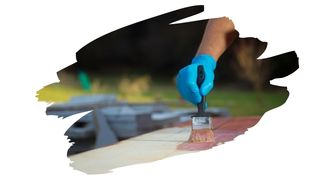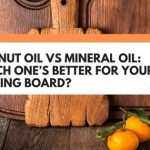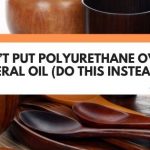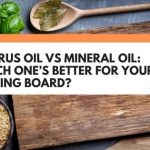Wood stains work best when they’re applied onto clean dry timber. And this means making sure the surface of your wood craft is free of sawdust, dirt and grease.
That’s because if wood is contaminated, a penetrating wood stain won’t be able to evenly soak into wood grain. And you could end up with a blotchy looking coat of color.
Now, when it comes to wood cleaning solutions, mineral spirits always seem to come highly recommended. And yet, what is it about this solvent that makes it so great at prepping wood for oil-based stains?
Well, in this post you’ll find out what mineral spirits are really made from. You’ll also learn when you should use this solvent cleaner on wood…and when you should skip over it altogether.

This post may contain affiliate links to products that we receive a commission for (at no additional cost to you). Learn more here.
How Do You Prep Wood For Staining?
Penetrating wood stains work best when they’re applied onto a clean dry surface.
The wood itself needs to be free of any contaminants as well. So, any old stain and/or oil finishes must be stripped from timber, before you stain it.
That’s why prepping wood involves cleaning it with solvents (after its been sanded smooth, of course). And we do this by washing wooden surfaces with a fast-drying grease-dissolving solvent, such as mineral spirit.
And Just What Is Mineral Spirit Exactly?
Mineral spirits are a refined petroleum distillate solvent. It’s widely used as an additive in many cleaning products. But, it can also be found in some types of varnishes and paints as well.
Yet, what makes mineral spirits so good at cleaning contaminants off timber, is the fact that this solvent can break down grease. It can soften up even the most hardened oil finishes, and other deeply ingrained grease stains.
However, mineral spirits can only break down an oil-based penetrating wood stain. It is not strong enough to dissolve away most gel stain products.
Related Post: Will Mineral Spirits Be Enough To Remove Gel Stain?
Is Mineral Oil The Same As Mineral Spirit?
While mineral oil and mineral spirits are both petroleum distillate derivative products, they are not the same thing.
Mineral oil is much thicker and more viscous than mineral oil, because its refinement focuses on filtering out toxins. So, this non-toxic petroleum distillate product is food grade (meaning it is safe for human consumption).
In fact, Food-grade Mineral oil is the best oil finish for food prepping wooden surfaces. To find out more about the reason why, take a look at this post here: Walrus Oil Vs Mineral Oil: Which One’s Better For Your Cutting Board?
Mineral spirits on the other hand have been refined too, and they are a much thinner liquid than mineral oil. Yet, this petroleum-derived product remains toxic, and should always be handled with care.
Related Post: Can I Safely Put Mineral Spirits In A Plastic Container?
So Can You Put Mineral Spirits On Wood Before Staining?
Mineral spirits are an ideal mild solvent for cleaning wood in preparation for an oil-stain. It doesn’t cure into a solid resin, and it will evaporate away fairly quickly.
And, unlike pre-stain conditioners, mineral spirits won’t fill out wood pores and prevent stain from sinking right down into lumber.
Nevertheless, sometimes Mineral Spirits can leave behind a thin film after application. But, this largely depends on how that mineral spirit product has been refined. We dive more into this topic in our post here: Why Do Mineral Spirits Sometimes Leave Behind A Residue? (Revealed!)
Then That Means Mineral Spirits Are Safe Enough To Put On A Wooden Item?
Yes, so long as that wooden piece is free of any oil finish. Or, at the very least, free of any oil finish you want to keep.
You see, mineral spirits can break down grease and oils. And this solvent is strong enough to damage oil-based finishes such as Linseed oil, and some oil-based polyurethanes.
In other words, if you put mineral oil on an oil-based finish, it can dissolve them away.
Related Post: Can You Mix Linseed Oil With Mineral Spirits? [Best Practice Revealed!]
How Long Will I Have To Wait (To Stain) After Using Mineral Spirits?
Mineral spirits evaporate away fairly quickly. A low odor mineral spirit will take anywhere from 15 to 20 minutes to dry (and less in warmer climates).
While an odorless mineral spirit product will start to evaporate pretty much from the moment you remove its bottle cap..
And What Are Odorless Mineral Spirits? How Are They Any Different?
Odorless mineral spirits are mineral spirits that have been further refined, removing all odor-releasing chemical compounds from them. These aromatic compounds are called highly volatile shorter hydrocarbons.
By removing these hydrocarbons, this extra filtered version of mineral spirits isn’t as strong as it’s low odor counterpart.
And Do Mineral Spirits Leave Behind A Residue?
Low odor mineral spirits can leave behind a barely-there film of grease. It doesn’t feel as viscous to the touch as mineral oil, but it can still feel noticeably greasy.
An odor mineral spirit however, is so refined that it leaves next to nothing behind after it evaporates.
Related Post: Why Do Mineral Spirits Sometimes Leave Behind A Residue? (Revealed!)
To Wrap Up, Here Are The 3 Key Takeaways From This Post…
- 1). You can use mineral spirits to clean wood and remove oil and grease from its surface.
- 2). Penetrating wood stains work best if they’re applied onto clean dry surfaces.
- 3). Low odor mineral spirits can sometimes leave behind a very light yet greasy residue.
References:
Sherry, Angela et al. “Volatile hydrocarbons inhibit methanogenic crude oil degradation.” Frontiers in microbiology vol. 5 131. 3 Apr. 2014, doi:10.3389/fmicb.2014.00131



